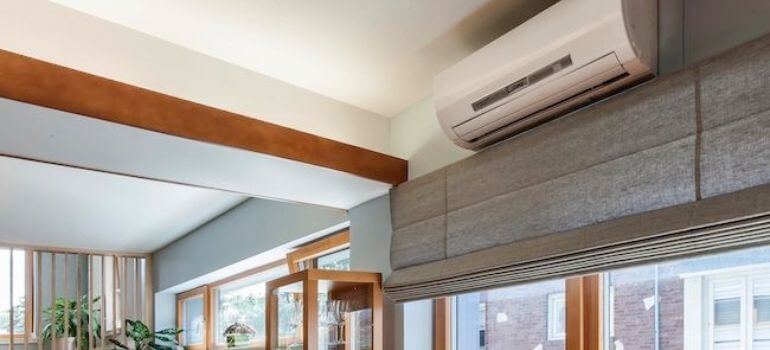As the mercury climbs, so does the importance of choosing the right air conditioner for your home or office. In the quest for cool, two contenders stand out: the tried-and-true window AC unit and the increasingly popular ductless mini split system. Both offer unique benefits and could be the perfect solution for your space. Yet, picking one over the other is not a decision to be taken lightly. This article will steer you through an air conditioner comparison that addresses efficiency, cost, installation requirements, and more, helping you make an informed decision for your cooling needs.
Key Takeaways
- Understand the basics and differences between window AC units and ductless mini splits.
- Evaluate the energy efficiency of each cooling option to determine potential long-term savings.
- Learn about installation requirements for a seamless set-up of your chosen system.
- Weigh the pros and cons of each system to assess which aligns with your personal comfort and budget.
- Consider how your local climate impacts the effectiveness of window units and mini splits.
Understanding the Basics of Window Units and Mini Splits
When it comes to room air conditioners, the market offers a variety of space cooling solutions to meet different needs. In particular, window units and ductless AC systems, commonly known as mini splits, stand out for their unique features and installation processes. Before settling on the ideal air conditioning for your space, it’s critical to understand the basic mechanics and requirements of each system.
Window units are true to their name — they are designed primarily for double-hung windows and are a go-to for a quick and straightforward installation. Their all-in-one nature means that every component needed for operation is contained within a single casing. This plug-and-play approach makes them highly appealing, especially for renters or those looking for a temporary space cooling solution.
On the other hand, ductless AC systems, or mini splits, are revered for their efficient and versatile room cooling capabilities. These systems comprise two primary elements: an outdoor compressor/condenser unit and one or more indoor air-handling units. Here’s a closer look at the components:
| Component | Function | Location |
|---|---|---|
| Outdoor compressor/condenser | Expels heat from indoors to outdoors | Exterior, near the space being conditioned |
| Indoor air-handling unit | Distributes cooled air within the room | Interior, mounted on the wall or ceiling |
What sets mini splits apart is their lack of ductwork, which is essential in traditional central air conditioning systems. Eliminating the need for extensive ducts enables an easier, more aesthetic installation, especially in buildings where interior ductwork is not feasible. Additionally, these units exert their prowess in zone cooling—each indoor unit can cool a separate room, permitting individual temperature control for enhanced comfort and efficiency.
Understanding these fundamentals of wall-mounted air conditioning is key to making an informed decision on the best room air conditioner for your environment. Whether it’s the simplicity and ease of a window unit or the sleek, zoning capabilities of a mini split, this knowledge serves as the foundation for grasping how these systems could influence your day-to-day comfort and convenience.
Comparing Energy Efficiency: Which Saves More in the Long Run?
Energy efficiency is a key factor in selecting the right cooling system, directly impacting the operational costs and environmental footprint of your climate control solutions. Diving into the world of window units and mini splits, we will evaluate their respective SEER ratings and energy-saving capabilities to help you make an informed choice for your long-term comfort and budget.
The Efficiency of Window Units
When considering window units, their efficiency is often gauged by SEER ratings, which measure the cooling output over a typical cooling season divided by the total electric energy input. While modern window units have made significant strides in efficiency, their SEER ratings typically cap at a lower threshold compared to mini splits. The implications on energy cost for these units can become pronounced over time, especially in regions with high utility rates or in homes where air conditioning is a constant necessity.
Mini Split Systems and Energy Conservation

Mini split systems generally boast higher SEER ratings, making them champions of energy savings. The advanced technology employed in these ductless systems allows for precise temperature control and reduced energy loss, contributing to their reputation for environmental stewardship. The targeted cooling capability of mini splits means that you can cool specific zones of your home without wasting energy on unoccupied spaces, further enhancing their efficiency and reducing operational costs.
Calculating the Cost-Benefit Over Time
While the upfront cost of mini split systems may be higher than window units, calculating the cost-benefit over time can shine a light on the true savings that can be achieved. Considering average electricity rates, cooling needs, and system efficiencies, homeowners can expect to recuperate the initial investment in a mini split through their energy savings within a few years. The table below outlines a comparative analysis:
| System Type | Average Initial Cost | Average SEER Rating | Estimated Annual Energy Cost | Break-even Point |
|---|---|---|---|---|
| Window Unit | $300 – $700 | 10-12 SEER | $150 – $250 | 3+ years |
| Mini Split System | $2,000 – $4,500 | 15-23+ SEER | $50 – $150 | 5-7 years |
By carefully evaluating SEER ratings, energy consumption patterns, and the resulting operational costs, consumers can navigate the complexities of air conditioning with ease and make choices that favor both their wallets and the planet in the long run.
Installation Differences Between Window Units and Mini Splits
When it comes to adding a new cooling system to your home, understanding the installation process is crucial. The approach you select may depend on whether you are looking for a quick DIY installation or if you’re planning to budget for professional installation costs. Let’s discuss the nuances between installing traditional window units and the more complex ductless mini splits, which usually require skilled HVAC contractors.
With the simplicity of window units, many homeowners are enticed by the possibility of a DIY project. Generally, the only requirement is having a suitable electrical outlet nearby and ensuring the window frame can support the unit’s weight. In contrast, mini splits entail a more detailed installation process. This includes tasks such as mounting the indoor unit, connecting refrigerant lines, and providing a proper power supply to the sophisticated outdoor unit. These steps often necessitate the expertise of a certified HVAC professional to ensure the system operates efficiently and safely.
- DIY Installation: Window units provide a manageable project for home enthusiasts, only requiring basic tools and no need for specialized knowledge.
- Professional Installation: Mini splits require a qualified technician to handle the installation, ensuring adherence to safety standards and optimal functionality.
Remember, while the upfront efforts and installation costs of a mini split system may be higher, the long-term benefits and efficiency can often justify the investment.
It’s important to weigh these differences and consider your own capability and budget before choosing between a window unit and a mini split system. The right choice will bring you comfort for years to come while remaining aligned with your personal preferences and financial plans.
Window Unit vs Mini Split: Pros and Cons
When it comes to selecting the right cooling system for your home, understanding the pros and cons of each type is pivotal. As energy costs rise and environmental awareness grows, homeowners are making more calculated decisions. Both window units and mini splits have characteristics that may serve as deal-breakers or deal-makers, depending on individual needs and preferences. Let’s delve into the advantages and disadvantages of both systems to facilitate a comprehensive cooling system comparison.
Pros of Choosing a Window Unit
- Affordability: Lower upfront costs make window units an accessible option for budget-conscious consumers.
- Easy Installation: Most can be easily installed without professional help, providing immediate relief from the heat.
- Portability: These units can be removed and reinstalled in different windows, allowing flexibility in cooling.
Cons of Window Unit Systems
- Noise: Window ACs can be quite noisy, which may affect comfort levels, especially in bedrooms or quiet spaces.
- Efficacy: They are generally used to cool single rooms, limiting their effectiveness in larger homes or spaces.
- Energy Efficiency: Often, window units are less energy-efficient compared to mini splits, leading to higher operating costs.
The Advantages of Mini Split Units
- Energy Efficiency: Mini splits are known for their energy-efficient cooling, often resulting in lower energy bills over time.
- Quiet Operation: With lower noise levels, mini splits provide a more peaceful environment.
- Longevity: These units can have a longer lifespan, leading to better unit longevity with proper maintenance.
- Multi-Zone Cooling: The ability to cool multiple rooms independently improves comfort and efficiency.
Drawbacks to Consider With Mini Splits
- Installation: Requires a professional HVAC contractor for proper installation, potentially increasing upfront costs.
- Cost: Generally more expensive initial investment than window units.
- Aesthetics: Some may find the indoor units less visually appealing than other cooling system options.
| Aspect | Window Unit | Mini Split |
|---|---|---|
| Installation | DIY-friendly | Professional needed |
| Upfront Cost | Lower | Higher |
| Noise Level | Higher | Lower |
| Energy Efficiency | Varies, often lower SEER | Higher SEER |
| Longevity | Shorter with heavy use | Longer lifespan |
| Cooling Capacity | Typically single room | Multi-zone cooling |
The Impact of Climate on Your Cooling Choice
The local climate undoubtedly plays a pivotal role in determining the most effective means of maintaining indoor comfort throughout the year. For those residing in areas with extreme regional temperatures, each degree of cooling can significantly affect your living space’s comfort and your wallet’s well-being. Thus, before opting for a window unit or a ductless mini split system, it’s imperative to understand how these devices stand up to the prevalent weather conditions in your region.
For dwellers in humid climates, the battle against moisture is as critical as temperature control. Air conditioning units pull double duty—reducing air temperature and lowering humidity levels. In such environments, a mini split system offers the additional benefit of improved seasonal performance, with its superior ability to manage humidity and distribute cool air efficiently. Conversely, the self-contained nature of window units might struggle in extreme humidity, potentially compromising their efficiency and cost-effectiveness in the long term.
Lastly, the nuances of seasonal performance should not be overlooked. While window units might suffice for moderate climates with mild summers and winters, areas experiencing fierce seasonality might benefit more from the flexibility and advanced functionality of a mini split system. Beyond just cooling, these units provide customizable zones and efficient heating options, which enhances their value as a year-round solution for ensuring optimal indoor comfort. As you weigh your options between a window AC and a ductless mini split, remember to factor in the full spectrum of your climate’s challenges—a decision that will promote not just immediate relief but also long-term satisfaction and efficiency.
FAQ
What are the main differences between a window AC unit and a ductless mini split system?
The primary differences lie in their designs and installation requirements. A window AC is a self-contained unit that fits in a window, providing a straightforward installation process ideal for DIY. On the other hand, a ductless mini split system consists of an outdoor compressor/condenser and an indoor air-handling unit, requiring a professional installation that includes mounting and connecting refrigerant lines.
When it comes to energy efficiency, how do window units and mini splits compare?
Generally, mini split systems are more energy-efficient than window units. Mini split systems have higher SEER ratings, indicating less energy usage for the same cooling effect. Window units can be cost-effective initially, but in the long term, mini splits may offer better energy savings due to their efficiency and zone cooling capabilities.
Can I install a window unit or mini split system myself?
Window units are typically suitable for DIY installation because they have been designed to fit into double-hung windows easily. However, mini split systems generally require professional installation by an HVAC contractor due to the complexity of mounting the units, connecting refrigerant lines, and ensuring a reliable power supply to the outdoor unit.
How does the cost compare between installing a window unit and a mini split?
The initial cost of a window unit is usually lower, and it can often be installed without professional help, saving on installation costs. Mini splits have a higher upfront cost and require professional installation, which adds to the initial investment. However, their higher efficiency can lead to longer-term savings on operational costs. It’s important to calculate the cost-benefit over time for a thorough comparison.
What are the pros and cons of using a window unit for cooling?
Window units offer several benefits, including lower initial costs, ease of installation, and a simple way to add cooling to a single room. However, the drawbacks include potentially higher energy costs over time, higher noise levels, and limitations on cooling capacity and energy efficiency when compared to mini split systems.
Are mini split units more advantageous than window units?
Mini splits provide several advantages, like improved energy efficiency, quieter operation, and the ability to perform multi-zone cooling, allowing for different temperatures in various rooms. The disadvantages to consider include the requirement for professional installation, higher initial costs, and potential aesthetic considerations due to the visible indoor units.
How does my local climate affect which cooling system I should choose?
Your climate plays a significant role in deciding between a window unit and a mini split. In areas with extreme temperatures, high humidity, or varied seasonal patterns, a system’s performance and efficiency can be significantly impacted. Mini splits tend to handle humid climates and maintain consistent indoor comfort more effectively, while window units may be sufficient for milder climates or temporary cooling needs.



